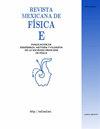Solution of the coupled β functions of the Standard Model and its minimal supersymmetric extension
Q4 Social Sciences
引用次数: 0
Abstract
The Standard Model contains three coupling constants α1, α2 and α3 associated to the intern symmetry groups. However, even such constants are named like that, in fact they are not, they are energy dependent functions. The functional form of the evolution satisfies a set of coupled differential equations the coupled β functions. In general these β functions are highly coupled, from this arises the necessity of using numerical methods for the solution of the problem, because it is not possible to obtain it analytically. In this work it is used the adaptive Runge-Kutta method for a set of ordinary differential equations. The physical motivation of this work arise from the fact that the coupling constants α1, α2 and α3 are associated to the electromagnetic interaction, the weak interaction and the strong interaction, respectively. In the Standard Model, the solutions for α1 and α2 intersect in a point, which can be interpreted as a unification of two fundamental interactions exists. Nevertheless, using the minimal supersymmetric extension of the Standard Model, the three coupling constants intersect in a region, reaching what is known as the Grand Unification.标准模型耦合β函数的解及其极小超对称扩展
标准模型包含与内部对称群相关的三个耦合常数α1、α2和α3。然而,即使这样的常数是这样命名的,事实上它们不是,它们是依赖于能量的函数。进化的函数形式满足一组耦合的微分方程——耦合的β函数。通常,这些β函数是高度耦合的,因此有必要使用数值方法来解决问题,因为不可能通过解析获得。本文采用自适应龙格-库塔方法求解一组常微分方程。这项工作的物理动机源于耦合常数α1、α2和α3分别与电磁相互作用、弱相互作用和强相互作用有关。在标准模型中,α1和α2的解在一个点上相交,这可以解释为存在两个基本相互作用的统一。然而,使用标准模型的最小超对称扩展,三个耦合常数在一个区域内相交,达到所谓的大统一。
本文章由计算机程序翻译,如有差异,请以英文原文为准。
求助全文
约1分钟内获得全文
求助全文
来源期刊

Revista Mexicana De Fisica E
社会科学-科学史与科学哲学
CiteScore
0.80
自引率
0.00%
发文量
14
审稿时长
>12 weeks
期刊介绍:
The Revista Mexicana de Física (Rev. Mex. Fis.) publishes original papers of interest to our readers from the physical science com unity. Language may be English or Spanish, however, given the nature of our readers, English is recommended. Articles are classified as follows:
Research. Articles reporting original results in physical science.
Instrumentation. Articles reporting original contributions on design and construction of scientific instruments. They should present new instruments and techniques oriented to physical science problems solutions. They must also report measurements performed with the described instrument.
Reviews. Critical surveys of specific physical science topics in which recent published information is analyzed and discussed. They should be accessible to physics graduate students and non specialists, and provide valuable bibliography to the specialist.
Comments. Short papers (four pages maximum) that assess critically papers by others authors previously published in the Revista Mexicana de Física. A comment should state clearly to which paper it refers.
 求助内容:
求助内容: 应助结果提醒方式:
应助结果提醒方式:


